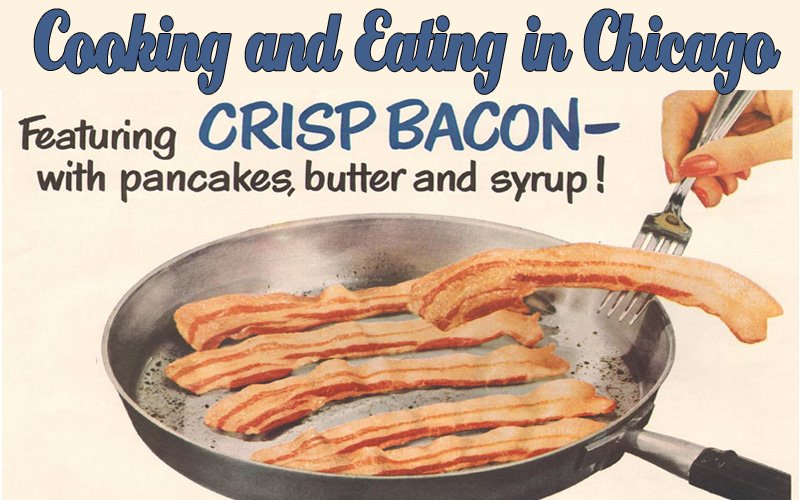
In my recent entry about Peoria Packing Butcher Shop, I talked about how I bought a pork belly to experiment with making my own bacon. Well, the process has come to its logical conclusion and I thought I'd share the results.
Bottom line; the bacon I made was good, but not great. I do, however, have a pretty good handle on what can be improved upon, so I believe that the next batch will be better.
Lacking the seminal Michael Ruhlman book
It's really a very easy process that's worth taking on, if only for the sake of going through the motions and learning how it's done. Here's a step-by-step walkthrough of what I did.
Step One: The Belly

As already noted, my belly was purchased at Peoria Packing, and I really didn't consider the choice very carefully--I just grabbed one randomly off the pile. The belly comes as one large floppy piece. I had trouble at first figuring out how this thing would end up resembling a slab of bacon, but after I cut it into three more or less equal pieces, it started to take shape. I got two good-sized blocks that I planned on using for my homemade bacon and one piece, from the scrawny end, that I figured I could use for braising or something.
In retrospect, the belly that I got at Peoria Packing wasn't all that great. It was pretty thin, resulting perhaps from sloppy trimming when the ribs were removed from the belly section. PP offers bellies with ribs on as well, so next time I may buy that cut and remove the ribs myself, leaving as much meat on the belly as I can. Or I may check Chicago Food Corp on Pulaski. There are also some other, more expensive options for getting high-quality bellies that I might pursue.
Step Two: The Cure
 I recalled, vaguely, from somewhere, that the basic ratio for curing meats is 10:5:1, meaning 10 parts salt to five parts sugar to one part pink salt (sodium nitrate, aka Prague powder). Pink salt is optional, but it helps preserve the color, adds flavor, and makes the curing process safer, inhibiting stuff like botulism, so I made a quick trip over to The Spice House in Evanston and picked some up. It's also available over the internet through websites like Sausagemaker.com.
I recalled, vaguely, from somewhere, that the basic ratio for curing meats is 10:5:1, meaning 10 parts salt to five parts sugar to one part pink salt (sodium nitrate, aka Prague powder). Pink salt is optional, but it helps preserve the color, adds flavor, and makes the curing process safer, inhibiting stuff like botulism, so I made a quick trip over to The Spice House in Evanston and picked some up. It's also available over the internet through websites like Sausagemaker.com.So, using that ratio, I mixed 500 grams of kosher salt, 250 grams brown sugar, and 50 grams of the pink salt. I decided to keep this cure really simple and just add black pepper for flavor, so I coarsely ground some peppercorns (about 75 grams) in my old coffee grinder
Then I liberally applied the cure to the belly pieces, put each one into a ziplock bag and tossed them in my old basement fridge on a sheetpan (in case the bags leaked). I turned the bags over every other day to make sure the cure soaked in evenly, and after a week in the bags, I took the bellies out, rinsed them, dried them well with paper towels, and put them in the fridge on a rack set over a sheetpan so they could dry off and form a pellicle. The pellicle is kind of a skin that forms that allows the smoke to 'stick' to the meat and also prevents too much moisture from being lost during the smoking process.
Step Three: The Smoke

The big challenge here was getting my Weber smoker, which is designed to 'hot' smoke at temps between 200° and 275° to run colder, so the pork bellies would cook as little as possible. The right way to smoke pork bellies for bacon is in a smokehouse or with an offset smoker, which allows for cold smoking.
But I don't have either of those, so I was determined to get my WSM to run at about 150° for the 3-4 hours I figured I'd need to impart a whole lot of hickory smoke flavor before the bellies would have a chance to cook much. Besides one pretty funny MacGyver-esque set-up, which some guy constructs using dryer exhaust venting, foil pie plates, cardboard boxes, and duct tape, what I found was that building a very small fire and keeping it just barely going was the way to go. That's what I did and I ran a pretty solid 150° for four hours.
Step Four: Slicing
 Slicing bacon by hand is hard!
Slicing bacon by hand is hard!After my bacon came off the smoker, I let it cool on a rack, then wrapped it in plastic and allowed it to firm up overnight in the fridge. The next day, I put the pieces in the freezer for a few hours and then took them out to slice them, which, I found, is no easy task.
I ended up with kind of a variety of thicknesses, basically due to my inability to consistently slice evenly, but that ended up being fine, since it allowed me to see how the various thicknesses cooked up. Cutting thicker slices is easier, and the thick slices cooked up nicer anyway, so that's what I'll go with next time around.
Step Five: Cook (and eat)
 So? How'd it turn out?
So? How'd it turn out?Well, like I said, pretty good, but not great. I'd leave it in the cure for a few days longer next time. The thinner parts of the belly had good salt and sweetness, but the thicker sections lacked flavor and tasted more like fresh pork. So 10 days of curing next time around, rather than the seven I did this time.
The smokiness was excellent. You can see by the black outer edges that the smoke really penetrated and flavored the bacon. It's got that really incredibly strong smokiness that you can smell as soon as you open the door of the fridge. I used hickory chunks and I'll do it the same exact way next time around.
The texture was varied. The thinner pieces, while crispier, also had kind of a chewy, jerky-like quality to them, while the slices that were cut thicker ended up being more tender, with that melting quality where the fat just kind of disintegrates in your mouth. Thick slices are better.
All in all, while I'm not going to subject my first run-through to the stringent review process of The Bacon List, I'm deeming this experiment a rousing success. The end result was certainly edible, and better than most grocery store bacon I've had. And while it falls short of something like a Niman Ranch or a Broadbent, I think the potential is there to approach that level of quality.
All in all, a fine diversion resulting in some pretty good breakfast meat. I'll certainly do it again and I'll keep you posted how things progress.












3 comments:
You should try the Chinese/Vietnames grocery store in uptown, on north Broadway, they have an excellent cut of pork belly.
Wow - how good does that look! Maple cure, whisky cure, so many things you could do..... maybe if I ever get time.
Nice, i'm a food lover, i love to eat different variety of mouth watering foods on1y with spices available naturally.
Post a Comment